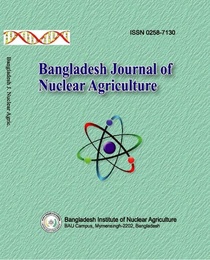PATTERN OF ORGANIC RESIDUE DECOMPOSITION IN SALINE SOILS
Abstract
A pot experiment was conducted to investigate the decomposition of incorporated organic residues in saline soil at the Laboratory of Soil Science Division, Bangladesh Institute of Nuclear Agriculture, Mymensingh. The experiment was arranged in completely randomized design (CRD) with three replications involving four levels of salinity , S0 = non saline water (0.7 dS m-1), S1 = 5 dS m-1 saline water, S2 =10 dS m-1 saline water and S3 = 20 dS m-1 saline water and three treatments of organic crop residues (C0 = no incorporation of crop residue, C1 = incorporation of rice residue @ 10 t ha-1 and C2 = incorporation of groundnut residue @ 10 t ha-1). Decomposition rate of organic crop residues were decreased with the increase of salinity level irrespective of crop residues. The decomposition rate of crop residues varied between 0.63 and 0.71 % per day. The highest decomposition rate (0.71% per day) was observed in non-saline soil (0.7 dS m-1 salinity level) and the lowest decomposition rate (0.63% per day) was observed at 20 dS m-1 salinity level. The decomposition rate of groundnut residue (0.72% per day) was higher compared to rice residue (0.64% per day). Approximately, 58% rice and 64% groundnut residues were decomposed within 90 days of incubation. The overall results suggest that organic residue decomposition was inversely correlated to the extent of soil salinity.
References
Asmalodhi, Arshad, M., Azam, F. and Sajjad, M.H. 2009: Changes in mineral and mineralizable N of soil incubated at varying salinity, moisture and temperature regimes. Pakistan J. Bot.41(2): 967–980.
Anjum, R., Ahmed, A., Jahangir M. andYousif, M. 2005: Effect of soil salinity/sodicity on the growth and yield of different varieties of cotton. Int. J.Agric Biol.4:606–608.
FAO (Food and Agriculture Organization), 2003. Organic matter, viewed 18th August 2007, <http://www.fao.org/ag/ca/doc/Organic matter.pdf>
Ghosh, A. B., Bajaj, J.C., Hasan, R.and Singh, D. 1983: Soil and Water Testing Methods: A Lab. Manual, Division of Soil Science and Agricultural Chemistry, IARI, New Delhi, India. pp. 30-48.
Haque, S.A. 2006: Salinity problems and crop production in coastal regions of Bangladesh. J.Bot.38: 1359-1365.
IPCC (Intergovernmental Panel on Climate Change) 2007: Climate change 2007: synthesis report. Available at :http://www.ipcc.ch/pdf/assessmentreport/ar4/syr/ar4_syr.pdf
Singh, K. P and Parwana, H. K. 1999: Ground water pollution due to industrial waste water in Punjab state and strategies for its control. IndianJ. Environ. Protect.19(4):241-244.
-
Download



